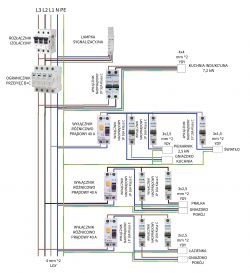Hello,
I'm moving to a new apartment and I'm going to do a little renovation
The apartment is about 50 m² - 3 rooms. I found out that it is possible to connect a 3-phase installation to the apartment.
I have made single-phase switchgears before, I even have some qualifications in this direction, but I wanted to consult colleagues who are up to date in the subject.
I made a switchgear diagram. These are the things that concern me most of all
1) RCD for induction - I met many posts / information from manufacturers that it is not required because the device will not be moved. If so, is it properly connected to the oven?
2) I selected the RCD for the other circuits with a higher current due to the possible expansion with an additional "S".
3) Have I missed something?
4) I can't find information whether the OMY cable can be flush-mounted. Maybe someone could answer my question please.

Regards
Peter
I'm moving to a new apartment and I'm going to do a little renovation
The apartment is about 50 m² - 3 rooms. I found out that it is possible to connect a 3-phase installation to the apartment.
I have made single-phase switchgears before, I even have some qualifications in this direction, but I wanted to consult colleagues who are up to date in the subject.
I made a switchgear diagram. These are the things that concern me most of all
1) RCD for induction - I met many posts / information from manufacturers that it is not required because the device will not be moved. If so, is it properly connected to the oven?
2) I selected the RCD for the other circuits with a higher current due to the possible expansion with an additional "S".
3) Have I missed something?
4) I can't find information whether the OMY cable can be flush-mounted. Maybe someone could answer my question please.

Regards
Peter




